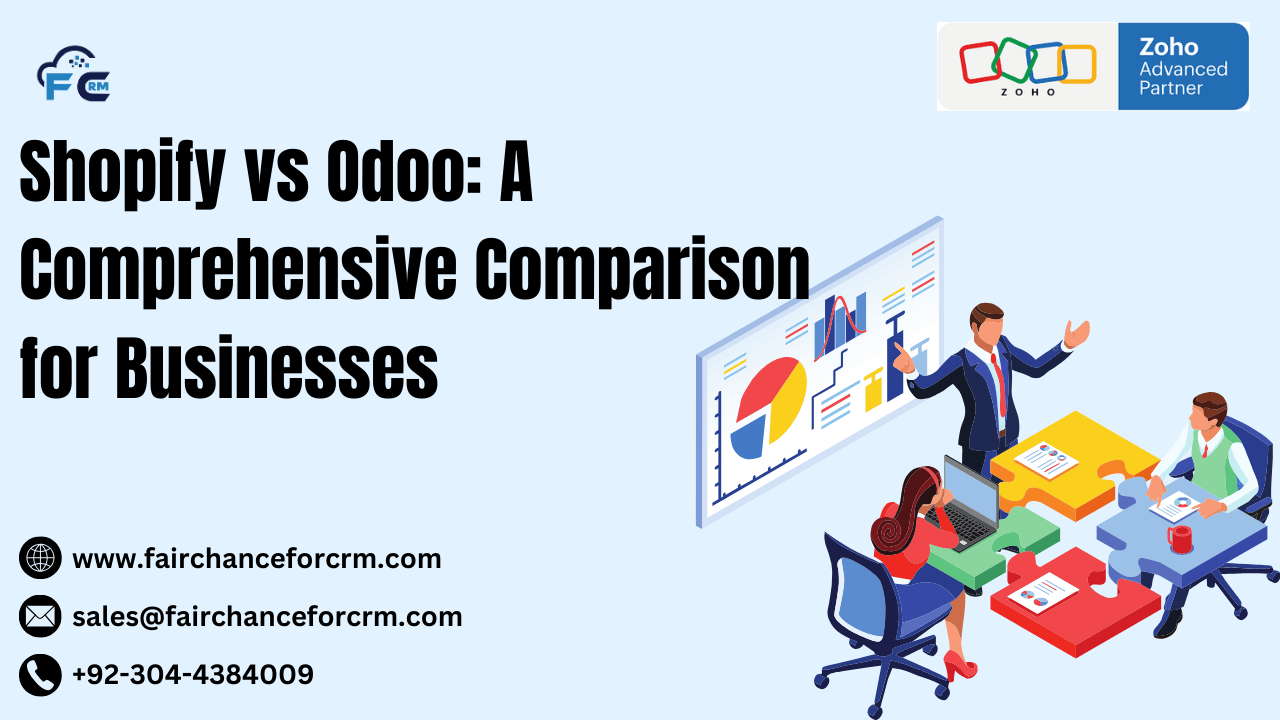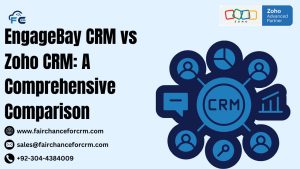When it comes to building an online store or managing business operations, two platforms often come up in the discussion: Shopify vs Odoo. While both are widely used by businesses of various sizes, they serve different purposes, with Shopify primarily focusing on eCommerce and Odoo offering a broader range of business management tools. In this article, we’ll compare the two, highlight key features, and provide coding examples to show how developers interact with both platforms.
Also Read:
- Maximizing Customer Engagement with Odoo Email Marketing
- Leveraging Odoo WhatsApp Integration for Enhanced Communication and Customer Engagement
- Zoho Flow How To Extract Webhook Data | FAIRCHANCE FOR CRM
- Zoho Deluge How To Check If Something Is Null | FAIRCHANCE
- Autofill Field Zoho CRM Deals – FAIRCHANCE FOR CRM
Shopify vs Odoo – Complete Guidance
What is Shopify?
Shopify is a popular cloud-based eCommerce platform that allows businesses to create, manage, and grow their online stores. Shopify provides an all-in-one solution to handle everything from product listing, payment processing, inventory management, marketing, and customer support. It’s designed for entrepreneurs, small businesses, and large enterprises that want to focus on selling products online.
Key Features of Shopify:
- User-Friendly Interface: Shopify is known for its easy-to-use interface, allowing even non-technical users to set up and manage their online stores.
- Customizable Themes: Shopify offers a range of themes (both free and paid) that allow for easy customization without needing to code.
- App Ecosystem: Shopify has a vast marketplace with apps that extend functionality, such as marketing automation, shipping integrations, and accounting tools.
- Built-In Payment Gateway: Shopify Payments simplifies payment processing by integrating seamlessly into the platform.
- Multi-Channel Selling: Shopify enables selling across multiple channels, such as social media, marketplaces like Amazon, and brick-and-mortar stores.
Example Use Case for Shopify:
A small clothing retailer uses Shopify to sell its products online. The retailer can easily upload product images, set prices, and manage inventory through a simple interface. Additionally, the retailer can set up Shopify’s marketing tools to run promotions on social media, boosting sales.
What is Odoo?
Odoo is a comprehensive suite of business applications designed to manage various aspects of a company. Unlike Shopify, which focuses primarily on eCommerce, Odoo offers a wide array of business management tools, including CRM, accounting, inventory management, project management, HR, and more. Odoo can be deployed as an all-in-one solution, making it ideal for businesses looking to integrate multiple functions under one platform.
Key Features of Odoo:
- Modular System: Odoo consists of a variety of apps that can be installed and customized based on the needs of your business.
- Customizability: Odoo is highly customizable, with both a user-friendly interface and the option to develop custom applications through Python and XML.
- Integrated Modules: Odoo offers everything from ERP, accounting, and sales to inventory, HR, and manufacturing management.
- Scalability: Odoo can scale with your business. You can start with a few modules and add more as needed.
- Open Source: Odoo is available as both a community (open-source) and an enterprise version, giving you the flexibility to modify the code to fit your requirements.
Example Use Case for Odoo:
A medium-sized manufacturing company uses Odoo to manage its entire business workflow, from inventory tracking, order processing, and accounting to managing customer relationships and HR functions. The company can automate processes, sync data across departments, and gain real-time insights into their operations.
Shopify vs Odoo: Key Differences
| Feature | Shopify | Odoo |
|---|---|---|
| Primary Focus | ECommerce platform | All-in-one business management (ERP) |
| Ease of Use | Very user-friendly with drag-and-drop features | More complex, but highly customizable |
| Customization | Limited customization (themes, apps) | High customization with code (Python, XML) |
| Integration | Integrates well with eCommerce tools and social media | Integrates with business apps like CRM, accounting, etc. |
| Pricing | Subscription-based, ranging from $39/month to $399/month | Open source (Community edition) or subscription-based for Enterprise |
| App Ecosystem | Extensive apps for marketing, sales, and eCommerce | Large ecosystem of business modules, more flexible |
| Payment Gateway | Shopify Payments + third-party integrations | Customizable payment gateways based on business requirements |
Example: Coding for Shopify vs Odoo Integration
Let’s look at a simple example of how developers can interact with both platforms.
Shopify API Example: Creating a Product
In Shopify, you can interact with the platform via its REST API. Here’s an example of how to create a product using Python:
This Python script will create a product on your Shopify store by sending a POST request to Shopify’s API with the product details.
Odoo API Example: Creating a Sale Order
In Odoo, you can interact with the platform using XML-RPC or JSON-RPC APIs. Here’s an example of creating a sale order using XML-RPC:
In this script, we use the xmlrpc.client library to authenticate to Odoo and create a sale order with customer and product details.
Which One is Right for Your Business?
- Choose Shopify if: You are primarily focused on running an online store with minimal technical overhead. Shopify is ideal if you want an out-of-the-box eCommerce solution with ease of use, built-in tools, and a large app ecosystem.
- Choose Odoo if: You are looking for a comprehensive ERP system to manage various aspects of your business (such as CRM, accounting, HR, and inventory) in addition to eCommerce. Odoo is highly customizable and scalable but requires more technical know-how to implement.
Conclusion
Both platforms serve different purposes and can even be used together in certain business setups, depending on your needs. For instance, you might use Shopify for eCommerce and Odoo for managing backend operations.
In conclusion, Shopify vs Odoo are both powerful platforms, but they cater to different needs. Shopify is perfect for eCommerce-focused businesses, while Odoo shines as an all-in-one business management solution, offering vast flexibility and customization for enterprises.
For more information about the Shopify vs Odoo, visit this link.
If you want to Free Trail Zoho, click on this link.




